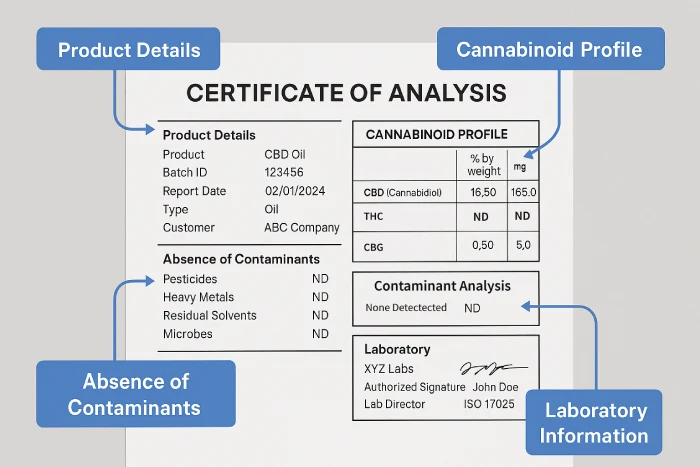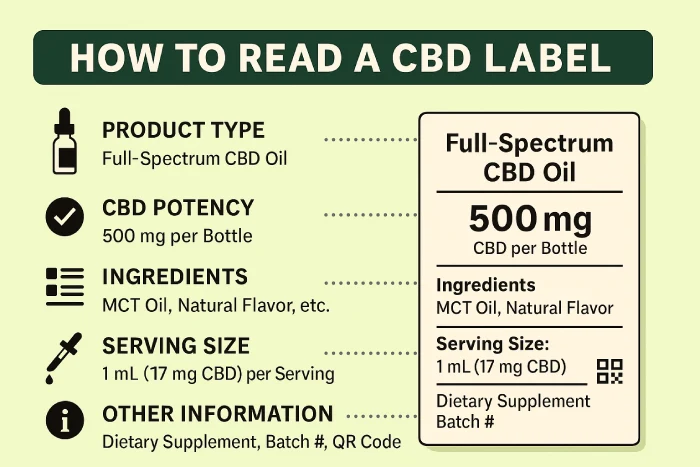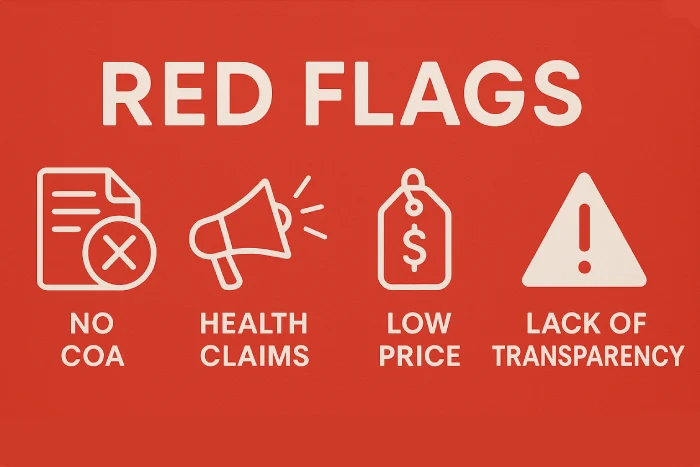At-A-Glance Summary
- Third-Party Testing: Always look for products with a Certificate of Analysis (COA) from an independent lab to verify CBD content and safety.
- Hemp Source: Choose CBD from U.S.-grown, organic hemp to ensure quality and compliance with legal THC limits (less than 0.3%).
- Transparency: Reputable brands provide clear labeling, COAs, and details about their manufacturing process.
- Red Flags: Avoid products with no COA, exaggerated health claims, or suspiciously low prices, as these may indicate poor quality.
- Controversy: The unregulated CBD market can lead to mislabeled products, so careful selection is crucial to avoid ineffective or unsafe items.
Key Steps to Choose CBD
- Check for Lab Testing: Look for a COA confirming the product’s CBD content, THC levels, and absence of contaminants like pesticides or heavy metals.
- Verify Hemp Source: Opt for U.S.-grown, organic hemp to ensure quality and legal compliance.
- Understand CBD Types: Full-spectrum (includes trace THC), broad-spectrum (THC-free), or isolate (pure CBD) suits different needs.
- Research the Brand: Choose transparent companies with positive reviews and clear manufacturing details.
- Read Labels Carefully: Ensure the label lists CBD potency, ingredients, and serving size accurately.
Avoiding Pitfalls
Be cautious of products without COAs, those making bold health claims (e.g., “cures cancer”), or ones priced unusually low.
These often signal poor quality or potential scams.
Always consult a doctor, especially if you’re on medications, as CBD can interact with some drugs.
Introduction
Cannabidiol (CBD) has become a popular wellness product, with potential benefits for conditions like pain, anxiety, and inflammation.
Learn more: What Is CBD? A Comprehensive Guide
However, the CBD market’s lack of consistent regulation means product quality varies widely.
Low-quality CBD may be ineffective, contain harmful contaminants, or fail to comply with legal standards.
This comprehensive guide outlines how to select high-quality CBD, highlighting the importance of third-party lab testing, red flags to avoid, and expert tips to make informed purchases.
By following these steps, you can ensure you’re getting a safe, effective, and legal product.

Understanding CBD and Its Types
CBD is a non-psychoactive compound derived from the cannabis plant, primarily hemp, which contains less than 0.3% THC (the psychoactive component).
Unlike THC, CBD doesn’t cause a “high,” making it appealing for therapeutic use.
Understanding the types of CBD is key to choosing the right product:
| Type | Description | Best For |
|---|---|---|
| Full-Spectrum | Contains all cannabis plant compounds, including up to 0.3% THC, potentially offering an “entourage effect” for enhanced benefits. | Those seeking maximum benefits and not concerned about trace THC. |
| Broad-Spectrum | Similar to full-spectrum but THC-free, retaining other cannabinoids and terpenes. | Those wanting entourage effect without THC. |
| Isolate | Pure CBD, with no other cannabinoids or compounds. | Those needing THC-free products or sensitive to other compounds. |
Why Quality Matters
The CBD industry is projected to grow significantly, but its unregulated nature poses risks.
With countless CBD products available, from oils to gummies, quality varies widely.
High-quality CBD ensures you get the intended benefits, like potential pain or anxiety relief, without harmful contaminants or legal issues.
Low-quality products may contain incorrect CBD levels, toxins, or excessive THC, which could cause unwanted effects or legal trouble.
Low-quality products may:
- Contain inaccurate CBD levels, reducing effectiveness.
- Include contaminants like pesticides, heavy metals, or solvents, posing health risks.
- Exceed legal THC limits, potentially causing legal issues or psychoactive effects.
- Fail to deliver promised benefits, wasting money.
Choosing high-quality CBD ensures safety, efficacy, and compliance with laws, such as the U.S. federal limit of 0.3% THC for hemp-derived products.

Key Factors to Consider When Choosing High-Quality CBD
1. Third-Party Laboratory Testing
Third-party lab testing is the cornerstone of CBD quality assurance. Independent labs verify a product’s contents and safety, providing a Certificate of Analysis (COA).
- What a COA Should Include:
- CBD and other cannabinoid concentrations (e.g., THC, CBG).
- Absence of contaminants like pesticides, heavy metals, solvents, and microbes.
- Confirmation that THC levels are below 0.3% for legal compliance.
- Lab Standards: Ensure the lab meets ISO 17025 standards or is accredited by organizations like the Association of Official Agricultural Chemists (AOAC), American Herbal Pharmacopoeia (AHP), or U.S. Pharmacopeia (USP). These standards guarantee rigorous, reliable testing.
- How to Access: Reputable brands make COAs easily accessible on their websites or product packaging, often linked to a batch number.
2. Source of CBD
The quality of CBD begins with the hemp plant.
High-quality CBD is typically sourced from U.S.-grown, organic hemp.
- Organic Farming: Hemp grown without pesticides or synthetic fertilizers is safer. Look for USDA Organic certification or brands that specify organic practices.
- U.S.-Grown Hemp: U.S. hemp is subject to stricter agricultural regulations, ensuring higher quality.
- Hemp vs. Marijuana: Hemp-derived CBD is legal federally if it contains less than 0.3% THC. Marijuana-derived CBD may have higher THC levels and is subject to stricter state laws.
3. Extraction Method
The method used to extract CBD from hemp affects the product’s purity and quality.
- CO2 Extraction: The gold standard, using pressurized carbon dioxide to extract CBD cleanly and efficiently, preserving beneficial compounds.
- Solvent Extraction: Uses solvents like ethanol or butane, which can leave residues if not properly removed. Check the COA for solvent levels.
4. Type of CBD
Choosing the right type of CBD depends on your needs:
- Full-Spectrum: Ideal for those seeking potential entourage effects but may not suit those subject to drug testing due to trace THC.
- Broad-Spectrum: Offers similar benefits without THC, suitable for THC-sensitive users.
- Isolate: Best for those needing pure CBD, often used in precise dosing or for THC-free needs.
5. Product Labeling and Transparency
High-quality CBD products have clear, accurate labeling:
- Ingredients: List all components, including CBD type, carrier oils, and flavors.
- CBD Potency: Specify CBD amount per serving and per container (e.g., 500 mg per 30 ml bottle).
- Serving Size: Provide recommended dosage instructions.
- Batch Number: Links the product to its COA for verification.
- Manufacturer Details: Include contact information and website.
6. Manufacturer Reputation
A reputable brand is transparent and trustworthy:
- Transparency: Shares details about sourcing, manufacturing, and testing.
- COAs: Provides easy access to lab results.
- Certifications: Holds Good Manufacturing Practices (GMP) certification or industry affiliations.
- Reviews: Has positive customer feedback and industry recognition.
7. Legal Compliance
Ensure the product complies with local laws. In the U.S., hemp-derived CBD with less than 0.3% THC is federally legal under the 2018 Farm Bill, but state laws vary.
Some states, like Idaho, require zero THC, while others allow marijuana-derived CBD for medical use.
CBD Red Flags When Buying
Be cautious of these warning signs when shopping for CBD:
| Red Flag | Why It’s a Concern |
|---|---|
| No COA Provided | Indicates lack of testing, risking inaccurate CBD levels or contaminants. |
| Exaggerated Health Claims | Claims like “cures cancer” are unproven and illegal, as CBD is not FDA-approved for most conditions. |
| Suspiciously Low Prices | Cheap products may use poor-quality hemp or skip testing, compromising safety. |
| Lack of Transparency | Companies not disclosing sourcing or manufacturing details may hide poor practices. |
| High THC Levels | THC above 0.3% in hemp-derived CBD could violate federal or state laws. |

Expert Buying Tips
To navigate the CBD market effectively, consider these expert tips:
- Research Reputable Brands: Start with brands vetted by trusted sources like from our carefully vetted list of THC free CBD products. Look for awards or industry recognition.
- Cross-Reference Information: Verify claims by checking multiple sources, including customer reviews and industry publications.
- Match Product to Needs: Choose full-spectrum for potential entourage effects, broad-spectrum for THC-free benefits, or isolate for pure CBD. Consider your sensitivity to THC or drug testing requirements.
- Consult a Healthcare Professional: CBD can interact with medications like blood thinners. Consult a doctor, especially if you have health conditions or take other drugs.
- Start Low and Go Slow: Begin with a low dose (5-10 mg) and gradually increase to find the optimal amount. Track effects to share with your healthcare provider.
- Check for Certifications: Look for GMP certification or USDA Organic labels to ensure quality manufacturing and sourcing.
- Verify COA Accessibility: Ensure COAs are linked to batch numbers and available online or upon request.
Common CBD Product Forms
CBD is available in various forms, each suited to different preferences:
| Form | Description | Best For |
|---|---|---|
| Oils/Tinctures | Liquid CBD taken sublingually for fast absorption. | Precise dosing, general use |
| Gummies/Edibles | Flavored, pre-dosed edibles with slower onset. | Convenience, discreet use |
| Topicals | Creams or balms applied to skin for localized relief. | Pain, inflammation, skin issues |
| Capsules | Pre-measured pills for consistent dosing. | Daily supplementation |
| Vapes | Inhaled CBD for rapid effects, but potential respiratory risks. | Experienced users, fast relief |
See also: THC-Free CBD product reviews
Conclusion
Selecting high-quality CBD requires careful consideration of third-party lab testing, hemp source, extraction methods, product labeling, manufacturer reputation, and legal compliance.
By avoiding red flags like missing COAs, exaggerated claims, or low prices, and following expert tips, you can confidently choose safe and effective CBD products.
Always consult a healthcare professional before starting CBD, especially if you’re on medications or have health concerns.
With diligence, you can navigate the unregulated CBD market and find products that meet your wellness needs.
Need Help Choosing the Right CBD?
Explore our vetted list of THC-free CBD brands or sign up for weekly picks delivered to your inbox.
About The Author
Joseph Powers is the founder of Legal CBD Idaho and a trusted voice in Idaho’s hemp and CBD space. With over a decade of experience in cannabis compliance and education, Joseph is committed to helping Idahoans confidently understand what’s legal, what works, and where to buy safe, effective CBD products in the state.
A Twin Falls local, Joseph brings a consumer-first approach to navigating Idaho’s strict laws around hemp-derived CBD. He personally reviews legal updates, verifies product claims, and explains everything in plain English—so you can make informed, stress-free decisions about your wellness.
Joseph is not affiliated with any CBD brand, ensuring every review and guide on this site is unbiased and rooted in facts, not hype. Whether you're just curious or looking for trusted products that meet Idaho’s 0.0% THC requirement, his goal is simple: to give you honest answers backed by research, not rumors.
Got a question about CBD in Idaho? Email Joseph directly at joe@legalcbdoilidaho.com.

